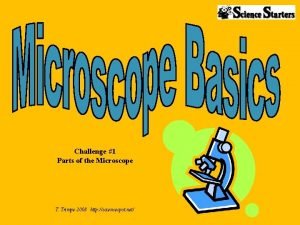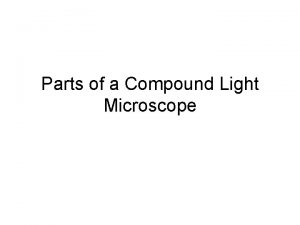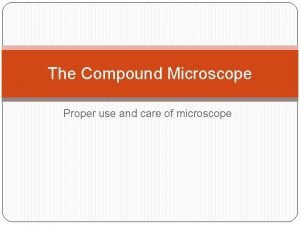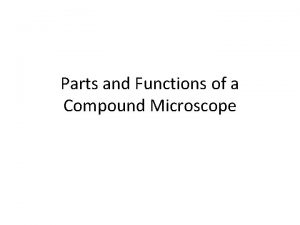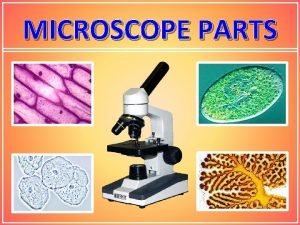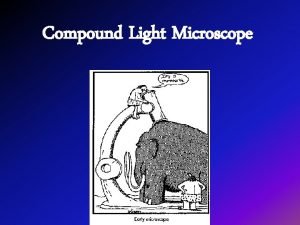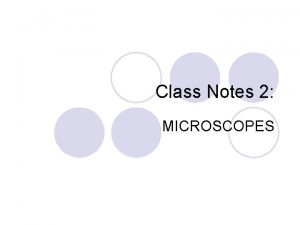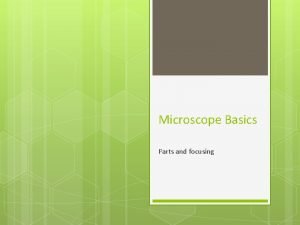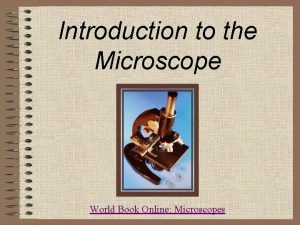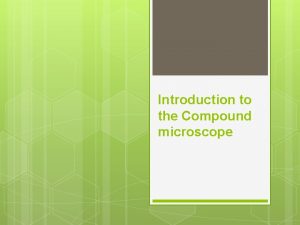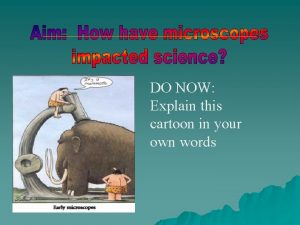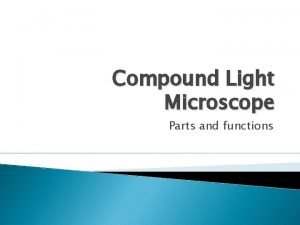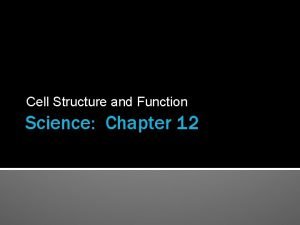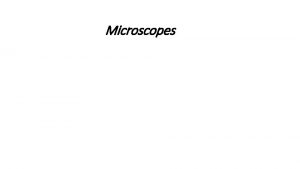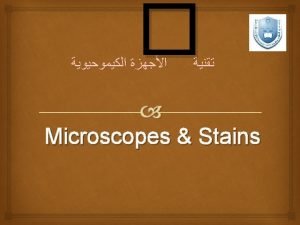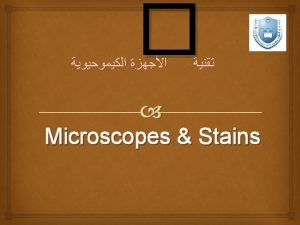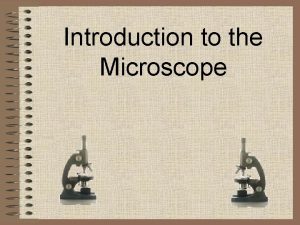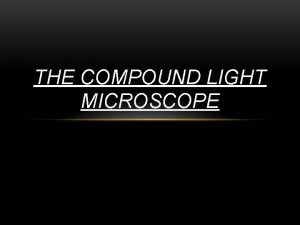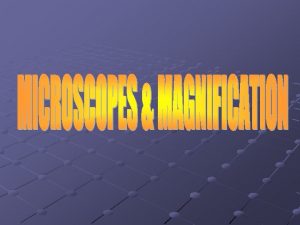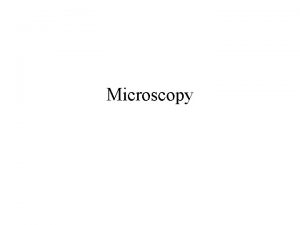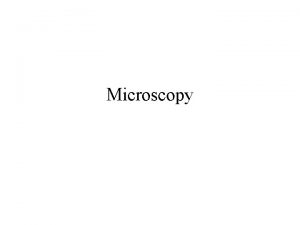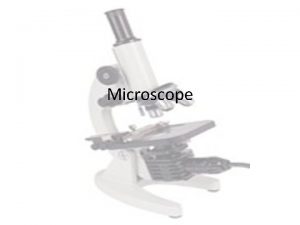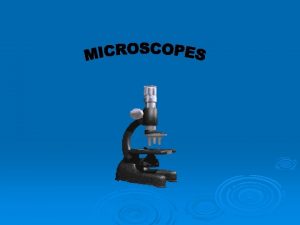Microscope to Function COMPOUND LIGHTmicroscope Uses light Magnifies














- Slides: 14

• Microscope to… Function COMPOUND LIGHTmicroscope Uses light. _______ Magnifies up 1000 X _____ STEREO 40 X _______ microscope Light cannot pass. _____ DISSECTING Also known as _______ scope _______ microscope Uses electrons ELECTRON COMPOUND LIGHT STEREOSCOPE 500, 000 X _____ ELECTRON MICROSCOPE

LIGHT MICROSCOPE eyepiece Body Tube Turrett Arm Focus Objective Low Objective Stage High Power Objective Stage Clips Course Adjustment Diaphragm Fine Adjustment Light Source Base

1. EYEPIECE 2. BODYTUBE 3. TURRETT 10. ARM 4. LOW POWER OBJECTIVE 11. 5. HIGH POWER OBJECTIVE 12. STAGE CLIPS 6. STAGE 13. COURSE ADJUSTMENT 7. DIAPHRAGM 8. LIGHT SOURCE 9. BASE FOCUS OBJECTIVE 14. FINE ADJUSTMENT

The focus objective focuses _____ 4 X 10 X The low power objective focuses _______ 40 X The high power objective focuses _______ Keep in mind, there is also a lens in the EYEPIECE 10 X that focuses _____ “ON TOP OF” the magnification of the objective lenses. TOTAL MAGNIFICATION Therefore, _______________would be: OBJECTIVE EYEPIECE ________ X _________ Practice: EYEPIECE X OBJECTIVE = TOTAL MAGNIFICATION OF FOCUS POWER 10 4 40 X __________ = _______ TOTAL MAGNIFICATION OF LOW POWER 100 X 10 X X _____ 10 X _____ = _______ TOTAL MAGNIFICATION OF HIGH POWER _____ X _____ = _______ 10 X 400 X

Where you place your eye. Contains ______LENS that ONE usually magnifies 10 x ______. Tube that supports EYE _______ PIECE the ______ and connects it to the TURRETT/NOSE PIECE _________.

Holds the SLIDE _______ in place _______ LENSES that magnify objects to varying “POWERS” _____. FOCUS OBJECTIVE: SHORTEST LENS (4 X) ____________ ONLY USED FOR SCANNING ____________ LOW POWER OBJECTIVE: SMALL LENS (10 X) ____________ LOW MAGNIFYING POWER ____________ HIGH POWER OBJECTIVE: ____________ LONGEST LENS (40 X) HIGH MAGNIFYING POWER ____________

Knobs that make adjustments FOCUS to the _______ Supports the MICROSCOPE _______ COURSE ADJUSTMENT MAKES LARGE ADJUSTMENTS _____________ USED WITH FOCUS AND _________________________ LOW POWER OBJECTIVES FINE ADJUSTMENT MAKES SMALL ADJUSTMENTS _____________ USED WITH HIGH POWER _________________________ OBJECTIVE ONLY

Directs light up through the DIAPHRAGM and _______ through the SPECIMEN _______ so that it may be VIEWED _______

Supports the SLIDE/SPECIMEN _________

Also known as the TURRETT ________. It is the rotating device that holds the LENSES OBJECTIVES (_____). _______/

An adjustable OPENING ________ under the stage, allowing different _____ AMOUNTS of _____ LIGHT onto the stage.

arm - _______________________________ this attaches the eyepiece and body tube to the base _______________________________ - this supports the microscope. body tube - the tube that supports the eyepiece. _____________________________ coarse focus adjustment - a______________________ knob that makes large adjustments to the focus. diaphragm - an adjustable opening under the stage, allowing __________________________ different amounts of light onto the stage. eyepiece____________________________ - where you place your eye. fine focus adjustment - a_______________________ knob that makes small adjustments to the focus (it is often smaller than the coarse focus knob). high-power objective - a_______________________ large lens with high magnifying power. inclination joint - an adjustable joint that lets the arm tilt at various angles. low-power objective - a small lens with low magnifying power. mirror (or light source)________________________ - this directs light upwards onto the slide. ______________________ revolving nosepiece - the rotating device that holds the ________________________ objectives (lenses). stage - the platform on which a slide is placed. stage clips - metal clips that hold a slide securely onto the stage. _____________________________

arm - this attaches the eyepiece and body tube to the base - this supports the microscope. body tube - the tube that supports the eyepiece. coarse focus adjustment - a knob that makes large adjustments to the focus. diaphragm - an adjustable opening under the stage, allowing different amounts of light onto the stage. eyepiece - where you place your eye. fine focus adjustment - a knob that makes small adjustments to the focus (it is often smaller than the coarse focus knob). high-power objective - a large lens with high magnifying power. inclination joint - an adjustable joint that lets the arm tilt at various angles. low-power objective - a small lens with low magnifying power. mirror (or light source) - this directs light upwards onto the slide. revolving nosepiece - the rotating device that holds the objectives (lenses). stage - the platform on which a slide is placed. stage clips - metal clips that hold a slide securely onto the stage.

 Microscope mania compound light microscope
Microscope mania compound light microscope Function of light switch in compound microscope
Function of light switch in compound microscope Light microscope vs electron microscope
Light microscope vs electron microscope Body tube microscope
Body tube microscope Mechanical parts of compound microscope
Mechanical parts of compound microscope All parts of microscope
All parts of microscope Microscope labeling
Microscope labeling Parts of a light microscope
Parts of a light microscope Anubikhan jantra
Anubikhan jantra University of delaware virtual microscope
University of delaware virtual microscope Compound light microscope definition
Compound light microscope definition When viewed with a compound light microscope the letter p
When viewed with a compound light microscope the letter p Compound light microscope parts and functions
Compound light microscope parts and functions 1886 modern compound light microscope
1886 modern compound light microscope Compound light microscope
Compound light microscope
